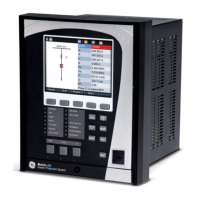CHAPTER 4: SETPOINTS DEVICE
850 FEEDER PROTECTION SYSTEM – INSTRUCTION MANUAL 4–23
Communications
The 8 Series relays have a two-stage communications capability. The base CPU supports
Modbus protocol through the Ethernet, USB, serial and WiFi port. In addition, the base CPU
also supports IEC 103, DNP serial, DNP TCP/IP, and TFTP protocol. Once the
communications module option is added to the base, the base Ethernet port becomes
disabled but the two Ethernet ports on the communications module have enhanced
communications capabilities such as IEC61850, IEC62439 parallel redundancy protocol
(PRP) and IEEE 1588 Precision Time Protocol (PTP). The communications CPU also supports
Modbus TCP, IEC 104, DNP TCP, TFTP, SFTP, and SNTP protocol.
RS485 On the rear card 8 Series relays are equipped with one RS485 serial communication port
and one 10/100
Mbps Ethernet port. The RS485 port has settings for baud rate and parity.
It is important that these parameters agree with the settings used on the computer or
other equipment connected to this port. A maximum of 32 relays can be daisy-chained
and connected to a DCS, PLC or a PC using the RS485 port.
Path: Setpoints > Device > Communications > RS485
BAUD RATE
Range: 9600, 19200, 38400, 57600, 115200
Default: 115200
PARITY
Range: None, Odd, Even
Default: None
PORT PROTOCOL
Range: Modbus, DNP 3.0, IEC 60870-5-103
Default: Modbus
WiFi WiFi refers to Wireless Local Area Networks (WLANs) that are based on the 802.11 set of
standards. WLANs are essentially providing Local Area Network (LAN) type of connectivity
but without the need of cables, which makes them more convenient for use in limited
spaces. WiFi works on top of the TCP/IP stack, the same as Ethernet. The signal strength
and its range is determined by the wireless device’s antenna technology and standard, the
best being IEEE 802.11n.
WiFi defines two modes of operation, namely ad-hoc, used for small deployments, and
infrastructure mode, which supports more robust types of security and better capabilities
for centralized management. The infrastructure mode requires an access point (AP).
Devices operating in this mode pass all data through the AP.
The WiFi module integrated on the 8-Series products conforms to IEEE 802.11b/g/n
standards. The 8-Series devices operate in infrastructure mode. Security is optional, but
enabled by default and it is advisable that it is left on, as wireless traffic is very susceptible
to cyber-attacks.
The security technology used is WPA2 (Wireless Protected Access version 2), based on the
IEEE 802.11i standard for data encryption. WPA2 is a second version of WPA technology,
designed to solve known security limitations found in one of the encryption algorithms
used by WPA, namely TKIP (Temporal Key Integrity Protocol). WPA2 uses CCMP (Counter
Mode with Cipher Block Chaining Message Authentication Code Protocol), which provides
an enhanced data cryptographic encapsulation mechanism based on AES (Advanced
Encryption Standard). CCMP makes WPA2 much stronger and secure than its
predecessors, WPA and WEP.

